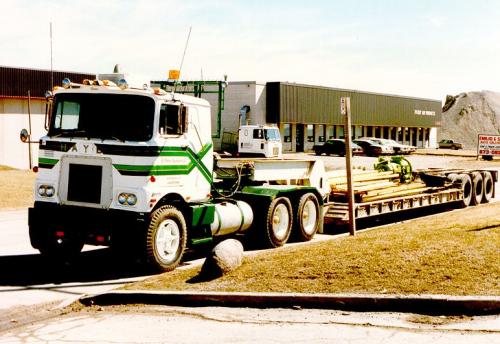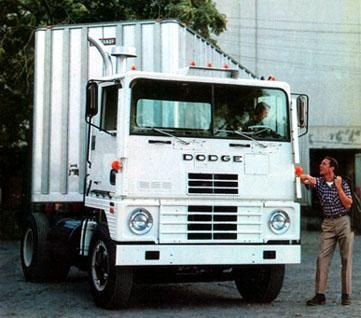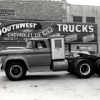-
Posts
661 -
Joined
-
Last visited
Content Type
Profiles
Forums
Gallery
Events
Blogs
BMT Wiki
Collections
Store
Posts posted by Phase 1
-
-
Outboard and snowmobile manufacturers have made great strides in two stroke technology and continue to do so. Arctic Cat snowmobiles has just taken another step in the advancement of the technology with a new injection system in a clean burning, efficient and economical two stroke. From a Snowmobile.com article: "modern and evolving direct injected two-stroke technologies led by companies such as Rotax, Evinrude, Orbital of Australia, Synerject in the US and others can point to the fact that two-strokes can be as emission friendly and miles per gallon efficient as four-strokes."
Possibly some of the modern gasoline two stroke technology can be utilized to make a two stroke diesel that meets the emissions regulations.
-
You would still have to spread the roof 4 ways I measured one already, I was hoping the sides were straight enough but theyre not, it would still look awesome with a 4" chop on an RW, that long wide flat hood with a chopped roof would look like an aircraft carrier deck.
There is a picture of an R model with a chopped top in this years ATHS Showtime ( just got it), on page 113.
-
The John Deere 8010/8020 came with a 6-71.
-
-but I would for milady.
-
Do you seriously joust?!!
No- it was in jest.
-
Haha Mack palace, full of jesters! But they are are very lovely.
Welcome to bmt! Nice to have ya!
I'm a jouster....
Lovely ??? maybe not......
-
Do you have or can you borrow some wheels and tires to try on the front just to diagnose it? Or swap wheels front and rear and see what happens.
-
-
What was the point of the twin engine cabover? Looks like it would be unwieldy in traffic.
bulldogboy
This is the truck BDB asked about.

There was an article about it in Wheels Of Time some years back. The owner wanted more power so he added another engine.
-
 1
1
-
-
Unlike most Clipper 100 COEs with Allentown F-model based cabs, these units had Hayward production "Mack Western" cabs.

That doesn't even look a lot like an F. A good looking truck on big spokes. Good picture.
-
 1
1
-
-
-and Beer!
-
Believe it or not, at one time, there used to be two different valve covers used on these engines.
I think the deal was, but I'm not sure, if the engine was put in a General Motors product the valve covers were stamped "General Motors Diesel".
If it was installed in another application, as in a different truck or marine application the valve covers were stamped "Detroit Diesel"
That's what someone told me at one time.
I do know we had a '65 400 series Brockway with an 8V71 in it that had a "General Motors Diesel" in it.
And all the later '68 400 series Brockways we had had 8V71 "Detroit Diesels" in them!
So I'm not really sure whether that was the case and the '65 had a GM motor that slipped through our it had something to do with year?
Ron
General Motors did not call them Detroit Diesel until that time. The name change was better for marketing purposes. Other truck companies did not like the idea of having what was then known as a "GMC engine" in their trucks. They were known as a Detroit diesel in the early years, but were not badged that until after International Harvester started calling them that later on (as the story goes).
General Motors bought the Winton company, a two stroke diesel engine manufacturer, in order to make engines for locomotives. Later they developed the engine for trucks.
There needs to be a book written about Detroit Diesel.
-
 1
1
-
-
Oh in sure if it came to the states Fiat would badge it as a Dodge/Ram of some kind I bet.
Mike
The new Bighorn.
-
 1
1
-
-
It would be interesting to learn how it only got to 20,000 miles. Maybe something like an airport service truck or a large corporations grounds maintenance vehicle, or from a small township?. -Or is it really 120,000?
-
Used to be a FWD cabover tractor with the forward slanting windshield in a trailer park behind the shopping center across from the Pine Cone on old WI 29 in Schofield, WI. Was visible from the road, wonder if it's still there?
See if you can spot it in a satellite view.
-
Oshkosh did make a high cab, over the road COE, though I think there were few of them. As compared to FWD's over the road COE, there are many fewer pictures out there.Tried to find one but could not.
-
nice pics of history , the 1965 white & burgundy looks like a Dodge cab ! am I right ?
Here is a dodge.

From Sweptline.com
-
Great pictures.
-
thats a sweet truck right there. theres something about those old high rib tube type tires that are tough. you just dont ge that look with the newer radials.
That's what I've always thought. The dimensions of the old bias ply tires look better.
-
Thanks for the compliments Guys. I can't wait to get it done and out side to take a picture of it. It's probably not going to make Mucungie, but you never know. I think it should make Watts and Gerharts. I'd have to look up the paint code. It's a Mercedes Green. Thanks, Josh
GM had a green like that in the early 70's.
-
That sightliner is a real Rube Goldberg of a truck. Strange how they take a cab from one model and mold it into something else. Like the Ford Two story Falcon, the Highbinder, and likely a few others I can't say right now.
It was fairly common to use a conventional cab for a COE, and many of the early ones (1930's - 40's) were made that way.
In addition to Ford doing it with the H model, the International Emeryville "floor over axle" high COE also used a cab that had begun life as a low-tilt COE model. Hendrickson also did it using the same cab, which was originally a Diamond T cab. What was unusual was that International then used that cab to make a conventional truck with a cab from a COE. The Emeryville COE cab was used on the Emeryville 400 conventional series - and it looks unusual too. The long hood version is referred to as the Donald Duck because that is what it looks like. The only other one I can think of was when GM used a Titan/Astro COE cab to make the General/Bison conventionals in the late 70's - although it had changes for conventional use, including smaller windshields.
Dodge used a cab from a conventional on the cab-forward C series, which was normal, but then stopped using it on conventionals. Then in later years the cab was moved back to the conventional position on the CN and CNT models. Dodge also made an unusual move when it used the cab from the A100 pickup on the low-tilt COE, model L.
An Emeryville conventional:
-
I believe these are the trucks you speak of. Brian Schwind Trucking from Sheboygan WI. I used to deliver up to Sheboygan and Kohler WI
and I would always see a nice looking black Cruiseliner running around and I thought it was neat that somebody was still running one, but
little did I know that there are about 15 still rolling and was very cool to see them all roll into the Waupun Truck n Show.
I saw one of them about a week ago that was almost pure white with salt. It made me cringe to think what the salt was doing to the metal on one of those nice trucks.
-
How long did Mack offer these?
1965 to 1970, 450 built.
It's interesting that in the brochures posted, it says that the R410 features a vertical engine !? Don't quite understand what they were getting at.
-
The old-timers used to call 'em Bi-Focal Internationals (fits)! There was a story in WOT awhile back,where Dallas Daggett (Daggett Truck Lines) said when they hooked one up to a van trailer,it looked like a "loaf of bread pushing an ant"!

They were also known as the "flying saucer". The yellow one looks like it was a government agency owned truck. There were not too many of them, probably sales were low because they were so strange looking.
I hope he does something with that one other than letting it rust away there. Probably one of those "I'm going to fix it up some day" stories, and it will sit until it is too far gone to save.





Old R700 with a heavy load
in Antique and Classic Mack Trucks General Discussion
Posted
Always liked this one.
http://www.youtube.com/watch?v=V-yrdx5WP_g